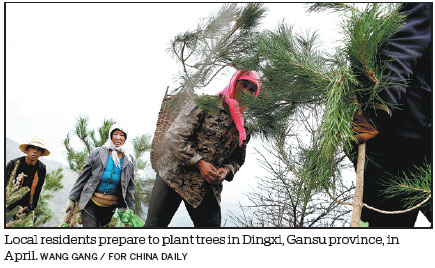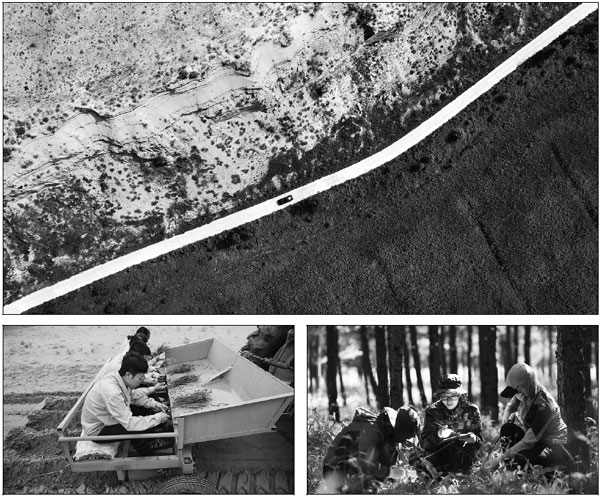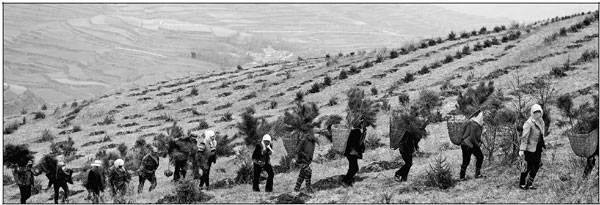NEW FORESTS HALT DESERTS' ADVANCE




Government campaign helps transform barren land
Of the 47,000 most-used Chinese characters, nearly 1,500 have wood as a pictographic component, showing the natural resource's importance to Chinese people's lives and culture.
Paper and printing blocks were made from wood, along with solid buildings that have stood for thousands of years in all kinds of weather. Old trees have been worshipped as patron saints by villagers.
Yet the country's mushrooming population has led to the rapid depletion of its forests. It took nearly 5,000 years for the population to reach 400 million by the middle of the 20th century, and only a further 50 years for it to reach about 1.4 billion.
In the 1950s, only 8.6 percent of the land was covered by forest. The proportion is believed to have fallen until the late 1970s, when the central government launched a national forestation campaign, which is still in effect.
The campaign has increased forest coverage by two and a half times in four decades.
Zhang Lianlian, 66, a farmer in Leipingta village, Ansai county, Yan'an, Shaanxi province, has been described by her fellow rural residents as a "tree freak".
She has been compared with the pine trees she has planted in that she cannot be felled by any difficulties, or collapse under pressure.
Zhang and her family, which spans three generations, have planted at least 200,000 trees on 117 hectares of mountainous land since 1981.
"My father encouraged me to plant trees when he saw my hand-to-mouth existence in the village in 1981. He said that as long as I insisted on planting trees, life would eventually change," Zhang said.
Her father was deputy head of the Yan'an forestry bureau of at the time.
"I could not quite understand what he meant, but I thought the stark mountains would look better if covered in greenery."
Zhang transformed her family's 2 hectares of barren farmland. From dawn to sunset, she planted trees on the mountains, leaving her children at home tied to a bed with long straw ropes as her husband, Wang Yaowu, a carpenter, often worked far from home.

Her actions shocked many people, who branded her a "nerd". Some even herded their sheep on Zhang's mountain slope. The sheep quickly ate the buds springing from new trees, and storms easily destroyed a large number of these saplings, giving Zhang sleepless nights.
Her husband said: "I often tried to persuade her to give up. It takes a long time before the trees can be logged for money. I was afraid we would not even live that long. But every morning, she emerged stronger and more determined."
Zhang Erxing, director of the Leipingta committee, said: "We always saw a woman using a hoe on the mountain slopes in all weathers. Nobody knew where a woman like her, who was only slightly taller than the hoe, got all her energy from."
In the 1990s, Zhang Lianlian's efforts began to pay off. She contracted a large orchard from the village, and her son raised chickens in the forests and orchard. She won respect, and the villagers changed their minds about her.
Zhang Lianlian provides them with saplings for free and her son's business has created 300 jobs for locals. More than 40 families have been lifted out of poverty thanks to the help from her family.
Thanks to her, nearly all the families in the village have realized the importance of planting trees, and Leipingta village is now surrounded by 400 hectares of woods. Weng Dianlong, the village Party chief, said Zhang Lianlian has also helped to raise funds to build roads and support local education.
Zhang Lianlian said: "The changes in the village have finally allowed me to realize what my father meant. Trees change the ecology and prevent landslides. I hope I can be buried in woods when I die."
Yan'an is located in the center of the Loess Plateau, where the forest coverage rate has nearly doubled to more than 82 percent in the past two decades thanks to concerted efforts by the government and local people.
The amount of sand and soil carried from Yan'an by the Yellow River, which runs through the plateau, has fallen by almost 90 percent in the past decade because of rapid forest expansion.
Annual rainfall in the arid region has nearly doubled, and local planters have to erect umbrellas over each date tree in wet seasons in case the rain brings down the fruit.
The fact that Yan'an emerged from poverty early this month, way ahead of next year's deadline set by the central government, is partially attributable to its remarkable progress in forestation.
Gansu farm founded
In Gulang county, Gansu province, six men, ranging in age from 40 to 61, founded the Babusha Tree Farm in 1981, following the central government's call to launch the Northwest-North-Northeast China Shelter Forest Belt Project.
They contracted a southern border region of the Tengri Desert, which was moving south at a rate of 7 meters a year, threatening 30,000 farmers and more than 1,333 hectares of farmland.
Over the past 38 years, their efforts and those of their offspring have resulted in a 300-kilometer protective belt, consisting of 14,446 hectares of forest and 25,067 hectares of grassland. However, of the six men, two died in the early 1990s and two in the early 2000s.
He Zhongqiang, who is in his 50s and the son of one of the six, works as a tree planter at the farm. "My father told me that he felt sorry he had left me nothing apart from a few trees before he died in 1991. He fell sick because of overwork.
"Now is the best time for tree planters. We have the best conditions and policies for desertification control. There is no reason for me to quit," He said, adding that many friends had tried to persuade him to look for a city job.
Zhang Runyuan, the youngest of the six men, said: "At first, the work was extremely hard. We placed wheat straw around the saplings to fix the soil, otherwise a strong wind could blow away 60 percent to 70 percent of them.
"We lived in caves, and worked in shifts to prevent the saplings from being eaten by local farmers' sheep. This is even more important than planting trees sometimes," Zhang Runyuan said.
An oasis comprising trees, shrubs and grass has changed the situation. The tree farm workers can now secure more water to plant wheat, corn, melons and tomatoes to make the farm sustainable.
The workers are extending the forest belt to the north, and have planted more than 2,000 trees and shrubs since 2003.
Battle in Saihanba
Similar forestation and desert control projects have been witnessed at the Saihanba Forest Park in Hebei province and in the Kubuqi Desert in the Inner Mongolia autonomous region, which are located to the northeast and northwest of Beijing, respectively.
Three generations of forest park workers have created 7.47 million hectares of artificial forest out of a semidesert.
Chen Yanshu, 75, was one of the first five female workers to arrive in Saihanba in 1964, when she was 20.
"The lowest temperature in winter was -40 C, and the conditions were very harsh. I was motivated by the country's first female tractor driver, Liang Jun, and wanted to be like her. So I volunteered to go to places where I was needed by my nation."
Ren Zhongyuan, Chen's coworker, said: "Our saplings could not survive the cruel conditions. The rate of survival was 5 to 8 percent at first, so we did experiments and grew seedlings to make sure they could adapt to the environment. We adapted tree-planting machines to suit the local conditions."
Shi Chen, whose father and grandfather worked all their lives at the Saihanba Forest Park, went there after graduating with master's degrees in forestry.
"I grew up here, and I am emotionally attached to the woods. I think it is worthwhile dedicating my youth to the land as my father and grandfather did," Shi said.
The park now has more than 1,000 species of insect, over 700 types of plant, 256 animal species and 192 types of bird.
Kubuqi model
The Kubuqi Desert in northern China, the nation's seventh-largest, covers 13,900 sq km south of the Hetao Plain. Over the course of 30 years, thanks to support from the government, local people and enterprises, about 6,300 sq km of desert have been covered by grasses, shrubs and trees.
Locals plant herbs and erect solar panels to increase their income, and more than 100,000 residents have been lifted out of poverty.
The success of desertification control in Kubuqi has been termed the "Kubuqi model", and features concerted efforts by multiple parties.
Gao Eryun, a farmer in Guanjing village, Kubuqi, remembers how his father Gao Linshu - the given name means wood and tree - cherished a willow tree he brought to the village.
Gao Linshu was known for making that first tree in the region survive, for a few years at least, in the 1950s.
Gao Eryun said the local government played a crucial role in encouraging the farmers to contract barren land and plant trees in 1981, promising them they would own everything grown on the land.
While other farmers adopted a wait-and-see attitude, Gao Linshu became the first person to contract 133 hectares of sandy land to plant trees.
Gao Linshu traded two of his 10 sheep for a mule cart full of willows.
"He spent most of his time planting the trees in the sand. He was crazy about planting trees for years," Gao Eryun said.
By 1986, Gao Linshu had planted willows over an area of about 35 hectares. "He looked after the trees as if he was caring for a baby," his son said.
Gao Linshu planted some castor seeds later to obtain castor oil. On one occasion in 1990, when the average per capita annual income was about 300 to 400 yuan, he made 18,000 yuan from selling the oil.
He also volunteered to help locals who contracted barren land from the government. In 2000, the local government started to give farmers willows to plant for free. The tree planters were provided with subsidies.
By last year, the Gao family had turned 220 hectares of sandy land into woods, shrubs and grassland, and the village is now at the center of a 7,000-hectare oasis.
Local farmer Zhou Qiang, 36, moved back to his deserted home in Kubuqi four years ago to run a hospitality business to meet the rising tourist demand - there are now more than 20 tourist spots in Kubuqi, including Qixin Lake.
Zhou previously worked as a migrant worker in neighboring Dalad Banner for more than 10 years.
"There used to be no water, electricity or telephones. The corn grown on the barren land was barely sufficient to feed the sheep. There was no way out," Zhou said.
His home lies in the middle of a 50-km pathway across Kubuqi, and he can cater to more than 1,000 visitors a day in the peak tourist season.
Thousands of local families are earning a living in the catering and service industries.
Integrated forestation
According to the National Forestry and Grassland Administration, the amount of land in China lost to desertification each year has fallen to 2,400 sq km, compared with expansion of about 10,400 sq km annually late last century.
The area of sandy land has fallen to about 1,900 sq km each year, in contrast with an annual expansion of about 3,400 sq km late last century.
Liu Dongsheng, deputy head of the administration, said that thanks to the success of desert control and forestation efforts nationwide, the country has seen a "historical reversal from sand forcing humans to retreat".
"There are plans for all the remediable sandy land in the country to be restored by 2050," Liu said.
"We have often vowed to conquer the desert, but this too radical. It is very hard to transform the desert completely, because it is a landscape much like mountains and grassland that has existed long before humanity. What we can do is follow nature's laws, and control the harm it causes and use its advantages to serve the people."
Economic interests have always been a key factor fueling forestation. But experts said every yuan the government spends on this is worthwhile, as the efforts have not only transformed farmers' incomes, but provided an environmental bonus for the whole country.
In addition to these efforts, China designated March 12 as national Tree Planting Day, when voluntary tree-planting activities are organized every year.
State leaders invariably take part in this national campaign every year, and it is estimated that over the past four decades more than 70 billion trees have been planted.
Statistics show that about 25 percent of new forest that appeared globally from 2000 to last year was in China. The country has the world's largest area of artificial forest coverage, reflecting the progress that has been made.
Over the past 40 years, the nation's forest coverage has risen from 115 million hectares to 208 million hectares, and the proportion of its forest coverage has expanded from 12 percent to just over 21.5 percent.
Zhang Jianlong, minister of the National Forestry and Grassland Administration, said, "China is considering a new round of large-scale forestation to continue the momentum in an attempt to raise forest coverage to 23.04 percent by 2020, 26 percent by 2035 and to 30 percent - the global average - by the middle of this century."
The forestation projects will be integrated into other related work, such as poverty alleviation, urban construction, rural development, pollution control, environmental restoration and ecological preservation, which is also in line with the public's need for a better environment.
The country will expand its government-funded forestation projects, improve the overall quality of its forests, attract more funds to drive these efforts, develop professional enterprises in the field of environmental restoration, and further expand urban, suburban and countryside green space, Zhang Jianlong said.
Contact the writers at liyang@chinadaily.com.cn

|
Clockwise from top: A bird'seye view of the Maowusu Desert in Yulin, Shaanxi province, one of the four major deserts in the country. Tao Ming / Xinhua; Workers collect data at the Saihanba Forest Park in Chengde, Hebei province. Wang Xiao / Xinhua ; Licorice roots are planted in the Kubuqi Desert, Inner Mongolia autonomous region, in an effort to bind the sand. Liu Wenhua / China News Service |
|
Locals plant trees in Weiyuan county, Gansu province. Wang Gang / For China Daily |
(China Daily Global 05/24/2019 page1)
















